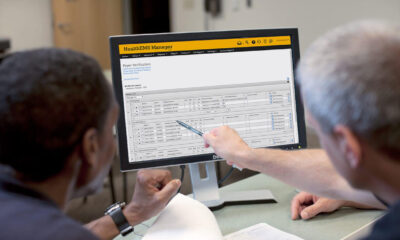Tech
Facebook’s Zuckerberg Clubhouse Could Change How You Advertise

A Facebook app, such as the Zuckerberg Clubhouse, is a great tool for marketers and sales people to use. It can help you target your advertising and create a better relationship with your clients. However, the social network is introducing changes that could make a significant impact on how you advertise.
App tracking transparency
In a new interview, Facebook CEO Mark Zuckerberg said he is confident the social network can handle the changes coming from Apple in its new iOS 14.5. The iOS update includes a new privacy feature called App Tracking Transparency. This feature will allow users to control tracking of their activity across apps. It also prevents app developers from selling their data.
On the Clubhouse show, Zuckerberg Clubhouse said that this change could help both businesses and consumers. He said he thinks that it would encourage more companies to sell products through Facebook and Instagram.
The new feature is expected to roll out in early spring. But there’s a downside: it will be only available to Apple iOS users. That means iPhone users will have to explicitly consent to tracking. As a result, Facebook’s ad-revenue may be hurt.
Some advertisers are concerned that this move will hurt their ability to track and serve targeted ads. Advertisers use metrics to determine whether or not their ad campaign is successful. Without IDFA, they will not be able to accurately measure the effectiveness of Facebook ads.
Targeting ads
Facebook is not just a social networking site. It’s also an ad platform. Zuckerberg Clubhouse, The company generates tons of money by allowing businesses to run ads. These ads allow the company to target specific audiences.
Facebook’s advertising business is based on retargeting, where it shows ads to people who have recently looked at something online. Often, these ads are for products users put in their digital shopping cart.
A lot of people don’t understand how Facebook’s advertising system works. But Facebook is growing, and it needs more advertisers to stay afloat. In recent months, some Facebook advertisers have noticed a few issues. For instance, ads are not working as well as they used to, and the Audience Network is having trouble processing ad requests.
The social media behemoth also recently stopped giving sales data by demographic cohort. This means it no longer reliably captures sales numbers. However, that’s not to say that it’s no longer a lucrative ad network.
Impact of social media apps on advertising
There is a lot of debate on the effectiveness of social media apps on advertising. However, there are many positives to using social media. These include the ability to reach a large number of people with a short amount of time, collaborative activities, and the production of content.
For most businesses, the most important benefit is the ability to target consumers that would be most likely to purchase their product. Social media platforms are an ideal place to do this. They can also determine the quality of engagement. This is particularly useful for advertisers.
While many companies use social media marketing to promote their products, some are going too far and resorting to misleading tactics. This can have the unfortunate side effect of tarnishing their reputation.
The most important social media app on the marketing spectrum is probably the content that users share. Companies have become more aware of the benefits of transparency and sharing. Users who are satisfied with a company’s performance are more likely to recommend it to others. Using this information in conjunction with a targeted ad campaign, businesses can effectively engage and build trust with their customers.

Tech
A Comprehensive Guide About Build Applications with the Help of Node.js & JavaScript

Node.js is an open-source, cross-platform, back-end JavaScript runtime environment that executes JavaScript code server-side. It allows developers to build fast and scalable network applications, making it one of the most popular choices for building web applications. This comprehensive guide will discuss how to build an application using Node.js and JavaScript.
Getting Started With Node.js
Before diving into the building process, it’s essential to have a basic understanding of why you need to Hire Nodejs Developers and how Node.js is built on Chrome’s V8 JavaScript engine and utilises an event-driven, non-blocking I/O model, making it a perfect fit for building fast, scalable network applications.
To start with Node.js, you first need to install it on your computer. You can download the latest version of Node.js from the official website (https://nodejs.org/). Once installed, you can verify the installation by running the following command in your terminal or command prompt:
node -v
This command will display the version of Node.js installed on your computer.
Setting up the Development Environment
Now that you have Node.js installed, you must set up your development environment. We will use Visual Studio Code as our code editor for this guide. Visual Studio Code is a free, open-source code editor developed by Microsoft that supports various programming languages, including JavaScript.
To set up Visual Studio Code, you can download it from the official website (https://code.visualstudio.com/). Once installed, open Visual Studio Code and create a new project by clicking on File > Open Folder. Select the folder where you want to store your project and give it a name.
Creating a Node.js Project
With the development environment set up, you can now start creating a Node.js project. To create a new project, open your terminal or command prompt and navigate to the project folder using the cd command. Once in the project folder, run the following command to initialize a new Node.js project. While on the other hand, if you are willing to create a new Node.js project. It is crucial to Hire JavaScript Developers that help to generate machine code for JavaScript-based apps that can be enabled on several platforms. Node.js already has a set of libraries to run JavaScript applications at runtime.
npm init
This command will create a package.json file, the manifest file for your Node.js project. The package.json file contains information about your project, including the dependencies and scripts required to run your project.
Installing Dependencies
To build a Node.js application, you often need to install additional packages or modules that provide additional functionality. These packages can be installed using the npm (Node Package Manager) command.
We will use the Express framework to build our application for this guide. Express is a minimal, flexible, and widely-used framework for building web applications with Node.js. To install Express, run the following command in your terminal or command prompt:
npm install express
This command will install the latest version of the Express framework and add it to the dependencies section of your package.json file.
Building the Application
With the development environment and dependencies set up, you can now start building your Node.js application. To start, create a new file in your project folder and name it index.js. This file will be the entry point for your application.
In the index.js file, import the Express framework using the following code:
const express = require(‘express’);
const app = express();
Next, you can set up the routes for your application using the app. get method.
Tech
How Managed IT Services Can Enhance Cybersecurity

Keeping up with IT operations can be time-consuming and resource-intensive. MSPs can help by liaising between your business and technology vendors.
MSPs can also provide access to state-of-the-art security tools that are cost-effective for small businesses. To reduce surprises, they can build the anticipated hardware breakdowns and repair costs into monthly fees.
Protecting Your Data
Many small businesses sit ducks in today’s rapidly evolving cyber threat environment. They lack advanced anti-malware protection, data backups, and employee training on cybersecurity best practices, making them vulnerable to phishing scams and other threats. IT service providers help protect business systems by monitoring networks, identifying potential vulnerabilities, and implementing the proper fixes to maximize security. They also provide regular risk assessments and reports to keep businesses up-to-date on regulatory compliance, reducing the risk of fines and reputational damage.
Most important, managed services Anchorage help companies save money. By leveraging the expertise of IT professionals, they can minimize expenses by freeing up internal resources to focus on the things that make them successful – like delighting customers and growing their businesses. Outsourcing IT needs to an MSP can be a cost-effective solution for businesses of all sizes.
Keeping Your Network Secure
Cyber attacks are a serious threat to business technology systems and data. An IT team can install and update the latest software to reduce or eliminate malware. They can also help with penetration testing to identify weaknesses that attackers could exploit.
An IT service can also back up critical data regularly. This protects against accidental deletion, hardware failure, and malicious attacks. It also ensures that the most recent version of your data is available if you need to recover from a disaster. A managed IT services provider can also help small businesses formulate effective incident response and disaster recovery plans to minimize the impact of a security breach. They can also help educate employees about the best practices for securing data. This includes assessing employee computer behavior and implementing training programs like phishing tests to educate employees about common threats. This approach is more efficient than the traditional break-fix model and helps to keep costs low.
Keeping Up With Regulatory Requirements
Businesses face increasing regulatory requirements that can take time to keep up with. MSPs can help manage these compliance issues, allowing businesses to focus on their core business processes. MSPs offer firewall and intrusion detection/prevention services, malware protection, data encryption, penetration testing, patch management, and vulnerability scanning. These services provide a comprehensive cybersecurity solution for your network, protecting it against attacks and threats and helping ensure compliance with industry regulations. They can also train employees in security awareness, including recognizing phishing emails and other common cyber threats. They can also help you create and implement an incident response plan, reducing downtime and giving your staff confidence that they can quickly recover from a cyber attack or other disruption. Additionally, MSPs can provide secure backup and data recovery solutions that protect against data loss due to hardware failure or a malicious attack. This can reduce downtime and improve productivity.
Keeping Your Employees Safe
Managed IT services can monitor your network in real-time to detect and neutralize threats before they damage your business’s systems. They can also assist you with developing an incident response and disaster recovery plan to minimize downtime and loss of data. An MSP can also provide regular updates and patches for your software and systems to protect them from cyber-attacks and improve performance. They can also ensure that critical data is regularly backed up and can be restored quickly during a disruption.
They can also help your employees understand how to spot phishing attempts and use strong passwords and other best practices. They can even conduct employee training and assessments to identify areas needing improvement. Having an MSP can free up your internal IT team’s time to focus on meeting your company objectives and helping you grow. This can be an invaluable investment in your business.
Tech
Support.apple.com/iPhone/passcode: Your Key to iPhone Security

Smartphones in the modern day are storage facilities for private and confidential data. It is crucial to keep these priceless tools safe. Apple’s dedication to user security has resulted in the creation of a system—the passcode—that is essential to keeping your iPhone secure. It’s crucial to your device’s security because it acts as the first line of defence against intruders. We’ll be delving into the world of “Support.apple.com/iPhone/passcode” and seeing how it protects your precious iPhone.
With so much private data stored on our phones, protecting them has become a top priority. Apple is aware of this requirement and supplies a reliable way to safeguard your iPhone, the passcode. The passcode you set on your iPhone is a vital part of its security, serving as the first line of defence against burglars.
Exactly what does “Passcode” mean?
To protect your iPhone, you can set up a passcode, which can be a combination of numbers and letters. It functions similarly to a digital lock, prohibiting anyone from accessing your iPhone without your permission. Your passcode is the device’s first line of defence against unauthorised access to your personal information and other sensitive data.
Password Configuration
The procedure of making a password is simple. To create a password, do as follows:
- Free Configuration: To change your iPhone’s settings, open the “Settings” app.
- Choose this one: Passcode and Touch ID (or Face ID and Passcode)
- Toggle On Passcode: Select your device’s equivalent of the “Turn Passcode On” or “Set Up Passcode” option.
- Type in the Code: A prompt will appear asking for a PIN.
- Please Verify Your Password: To verify the password, please enter it again.
Your iPhone is more secure now that you have set a passcode.
The Value of a Robust Password
It’s important to use a strong passcode, despite the fact that it may be more convenient to use a weak one. Combining numeric digits with letters and symbols makes for a more secure password. This not only makes it more difficult for hackers to crack your account, but also keeps your private information safe.
Face ID and Touch ID
Apple’s Face ID and Touch ID are two of the most cutting-edge biometric authentication technologies available in today’s rapidly developing smartphone security landscape. Apple’s dedication to provide state-of-the-art, user-friendly security solutions has been bolstered in large part by these additions.
Face recognition:
The facial recognition technology behind Face ID is used for biometric authentication. It’s compatible with a wide range of iPhones and can be used to unlock devices, make secure payments, and launch apps with just a glimpse. Using a sophisticated 3D mapping of the user’s face, Face ID is an extremely safe means of identification verification. It’s not only practical, but also very precise, as it adjusts to new hairstyles and beard growth.
iPhone with Touch ID:
However, Touch ID relies on fingerprint scanning technology for identification. Once you scan and store your fingerprints, you can use them to unlock your iPhone, approve app downloads, and verify your identity in other situations. Furthermore, users widely adopt Touch ID because it unlocks their device with ease and speed.
It’s safe to use, and the only input you’ll need is the tip of your finger.
Both Touch ID and Face ID provide an extra security measure beyond passwords. These biometric solutions not only improve security but also make authentication quick and painless. Now that you know about the advanced security measures implemented on your iPhone, you can proceed to choose a method that aligns with your preferences and the capabilities of your device.
Tutorial on Changing Your Password
A good security measure is to periodically alter your passcode. Here’s what you need to do:
- Free Configuration: Get the “Settings” programme going.
- Passcode and Touch ID (or Face ID and Passcode): Choose this one.
- Alter Your Code: Follow the on-screen instructions after tapping the “Change Passcode” button.
The iPhone’s security can be improved by implementing regular passcode changes.
Tips for Resetting Your Password
Password forgetting is a common occurrence. However, Apple has account recovery options:
- Logon with Your Apple ID: In order to reset your passcode, your Apple ID must be linked to your device.
- Get in touch with Apple’s Technical Support: If you need more help, contact Apple’s support team.
Keep your passcode safe, but if you ever forget it and find yourself locked out of your iPhone, follow these instructions.
Apple ID Password vs. Passcode
When discussing iPhone security, it’s vital to differentiate between your Apple ID password and your passcode. You shouldn’t confuse these two parts because they do different things.
Key to your Apple ID is:
The Apple ecosystem is locked behind your Apple ID password. It allows you to log in to iCloud, the App Store, and other Apple platforms. To access the Apple ecosystem, manage your purchases, and sync and share your data, you need an Apple ID. Keeping your Apple ID password safe is essential for the protection of your digital persona and the Apple services to which you have access.
Passcode:
On the other hand, your iPhone’s passcode is only good on that one device. Additionally, it acts as a lock on the device itself, thereby protecting the information on your smartphone. One of its major goals is to protect your private data, including texts, images, and other media stored on your iPhone.
First and foremost, it is crucial to keep your Apple ID password and passcode separate and private. This is due to their immense importance in ensuring your digital safety. While your Apple ID password protects your digital identity, on the other hand, your iPhone’s passcode safeguards its contents. By having a firm grasp on these two concepts and using them wisely, you can keep your Apple devices safe.
Conclusion
Moreover, smartphones are an integral part of our daily lives, making their security a top priority. Furthermore, with a strong foundation of iPhone security, support.apple.com/iPhone/passcode guarantees that your private information is safe and sound. Additionally, Apple provides you with the tools to safeguard your digital life. These tools range from the option to create a complex passcode to utilising biometric authentication methods such as Touch ID and Face ID. As we conclude, it is important to remember that your iPhone passcode serves as the gateway to a secure, confidential, and personalised digital journey. Firstly, be careful. Secondly, keep an eye out. Lastly, rest easy knowing your iPhone is secure.
For Further Information Visit:https://cocoagraph.com/
-
Topics7 months ago
sous vide chicken breast
-

 Tech3 months ago
Tech3 months agoAn Interview With Samsung FastCompany VP Jaeyeon Jung
-

 Top3 months ago
Top3 months agoInterview With GoPuff CEO Rafael Ilishayev
-

 Tech3 months ago
Tech3 months agoA Comprehensive Guide About Build Applications with the Help of Node.js & JavaScript
-

 Home Improvement3 months ago
Home Improvement3 months agoNeed someone to help with the house cleaning? Check out our maid service!
-
Topics7 months ago
alpro oat milk
-

 Health3 months ago
Health3 months agoWhy MobileTouch HealthEMS Is Leading Health APP
-
Topics3 months ago
dessert near me